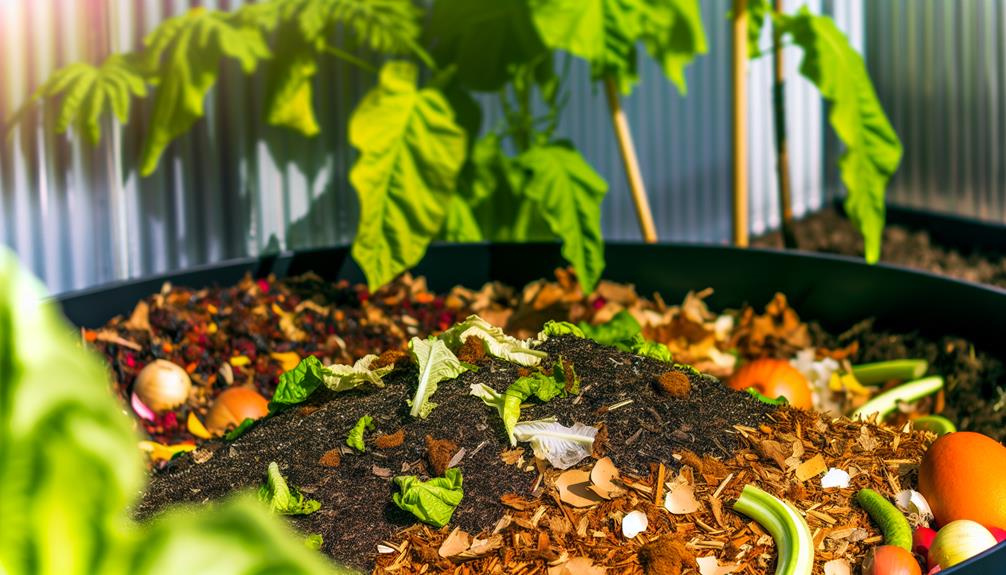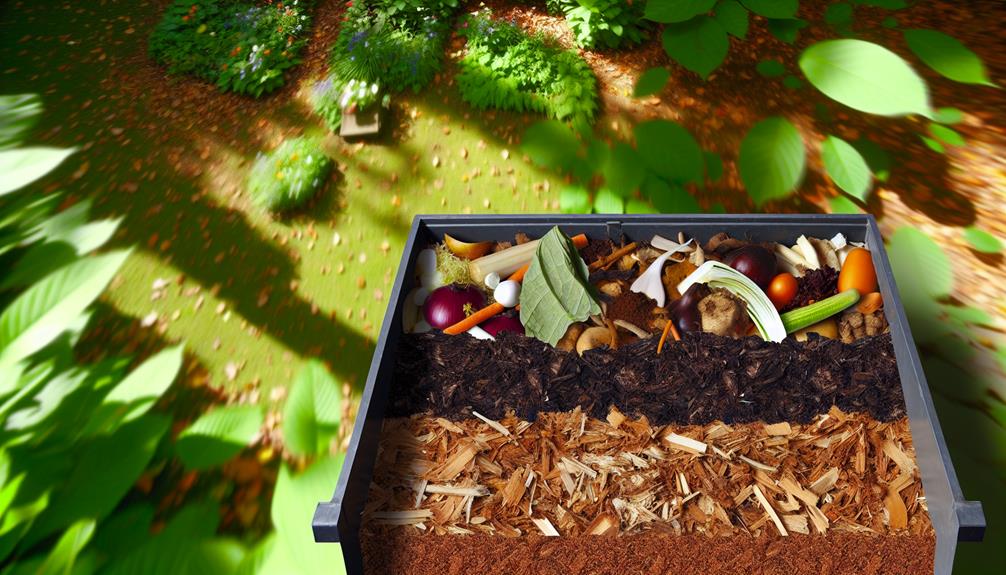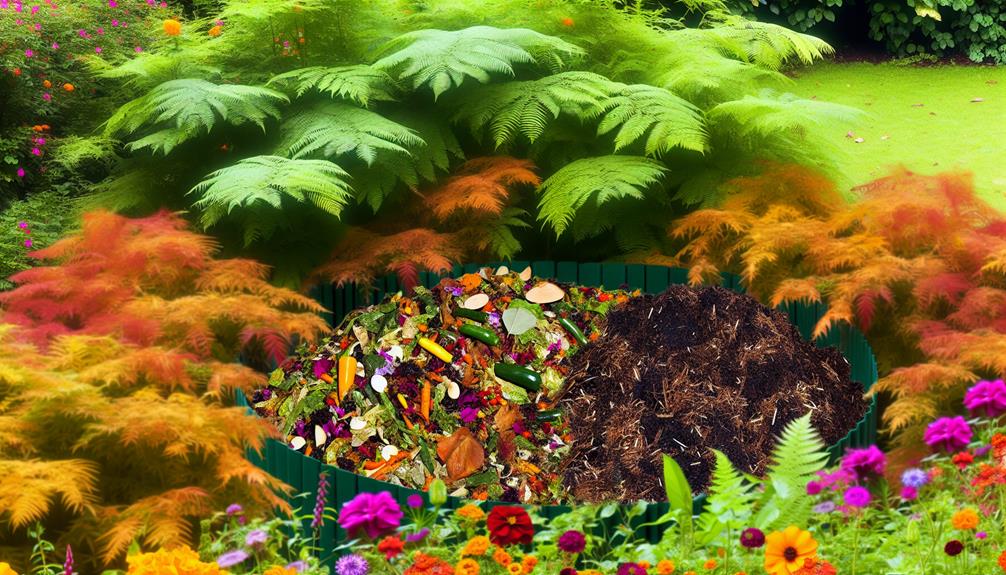

Yes, you can compost sawdust, but you’ll need to guarantee a proper balance of carbon and nitrogen. Sawdust is carbon-rich, so mix it with nitrogen-rich materials like kitchen scraps or grass clippings. Use only untreated sawdust to avoid harmful chemicals. Keep the carbon-to-nitrogen ratio around 30:1 for effective decomposition.
Make sure the compost pile stays moist, like a wrung-out sponge, and turn it regularly for aeration. Layer sawdust with other materials to avoid compaction. Properly managed, sawdust compost improves soil structure and moisture retention. To learn more about optimizing your composting process, consider detailed guidance available.
Composting sawdust can enrich your soil by adding valuable nutrients and improving its structure. By incorporating sawdust into your compost, you’re contributing to soil enrichment, which helps plants thrive. Sawdust is rich in carbon, an essential element for a balanced compost pile. When mixed with nitrogen-rich materials like kitchen scraps or grass clippings, it creates a nutrient-dense compost that supports healthy plant growth.
In addition to soil enrichment, composting sawdust improves moisture retention in your soil. Sawdust has a unique ability to absorb and hold water, reducing the frequency of watering and helping your garden maintain consistent moisture levels. This is particularly beneficial in dry climates or during hot summer months when water conservation is important.
To get started, simply mix sawdust with other compostable materials in equal parts. Make sure the pile is kept moist but not soggy. Turn it regularly to promote aeration and speed up the decomposition process. Over time, you’ll notice the sawdust breaking down and transforming into a dark, crumbly compost that’s ready to enrich your garden beds.
Also Read: Can You Compost Candy Wrapper?
When choosing sawdust for composting, always opt for untreated wood, as it breaks down naturally and enriches your compost.
Treated sawdust, on the other hand, can contain harmful chemicals that might contaminate your compost.
Stick with sawdust from hardwoods and softwoods that haven’t been treated with any preservatives or finishes.
Ever wondered why untreated wood sawdust is ideal for composting? It’s all about soil enrichment and moisture retention. Untreated sawdust is free from harmful chemicals, making it a perfect addition to your compost pile. When you use it, the sawdust breaks down naturally, releasing carbon that enriches the soil. This process not only improves soil structure but also helps in retaining moisture, which is crucial for healthy plant growth.
To make it easier to understand, here’s a quick comparison of types of sawdust and their benefits:
| Type of Sawdust | Soil Enrichment | Moisture Retention |
|---|---|---|
| Untreated Hardwood | High | Good |
| Untreated Softwood | Moderate | Excellent |
| Treated Wood | Low | Poor |
| Painted Wood | Very Low | Very Poor |
Using untreated sawdust helps create a balanced compost that’s both nutrient-rich and effective in holding water. You’ll find that your plants are healthier and your garden thrives more readily. Mixing it with other organic materials ensures a well-rounded compost pile. Remember, the goal is to create an environment where beneficial microbes can thrive, breaking down the organic matter into rich, fertile soil. So, stick to untreated sawdust for the best outcomes!
Selecting the appropriate type of sawdust is essential, so avoid treated sawdust to guarantee that your compost stays chemical-free. Treated wood, often used in construction or furniture, contains chemicals like arsenic, copper, and chromium. These chemical hazards pose significant health risks to you and your garden.
When you add treated sawdust to your compost, these harmful chemicals can leach into the soil. This compromises the quality of your compost and endangers the plants that rely on it.
You certainly don’t want to introduce toxic elements into your garden, especially if you’re growing vegetables or herbs meant for consumption.
To maintain a healthy compost, stick to sawdust from untreated wood. Look for sawdust from sources like natural, unfinished lumber or wood that hasn’t been painted, stained, or chemically treated.
If you’re unsure whether the wood has been treated, it’s better to err on the side of caution and not use it.
Also Read: Can You Compost Canned Fruits?
To achieve effective composting with sawdust, you need to pay attention to the carbon-nitrogen (C:N) ratio. Sawdust is high in carbon, so you’ll need to balance it with nitrogen-rich materials like grass clippings or kitchen scraps.

Aim for a ratio around 30:1 to make sure microbes can break down the compost efficiently.
Maintaining the correct C:N ratio in your compost is essential for effective decomposition and nutrient balance. The carbon-to-nitrogen ratio affects microbial activity, which is vital for breaking down organic matter. When you get the C:N ratio right, microbes thrive, accelerating decomposition and ensuring nutrients are available for your plants.
Sawdust is a carbon-rich material with a high C:N ratio, typically around 400:1. To balance this, you need nitrogen-rich materials, like kitchen scraps or grass clippings, which usually have a lower C:N ratio. Aim for an overall compost mix ratio of about 30:1 for the best results.
Start by adding a layer of sawdust, then follow it with a layer of nitrogen-rich material. Repeat these layers to create a balanced pile. Turning your compost occasionally helps maintain even microbial activity and prevents issues like odor or slow decomposition.
Monitoring your compost pile’s moisture and temperature also promotes a healthy C:N balance. If it gets too dry, microbes slow down; too wet, and they can’t breathe. Keep it as damp as a wrung-out sponge for the most favorable results.
Achieving the right balance of green and brown materials is essential for a thriving compost pile. To get this balance, you need to understand that green waste, like kitchen scraps and grass clippings, provides nitrogen. Brown materials, such as sawdust and dried leaves, offer carbon.
For your compost to break down efficiently, aim for a carbon-to-nitrogen (C:N) ratio of about 30:1. Sawdust is a brown material with a high carbon content, so you’ll need to mix it with plenty of green waste to keep the balance. Think of green waste as the fuel that gets your compost cooking, while brown materials act as the structure that keeps it aerated.
Start by layering two parts green waste to one part brown materials. If you notice your compost is too wet and smells bad, add more brown materials to soak up moisture and improve aeration. Conversely, if it’s too dry and slow to decompose, mix in more green waste to boost microbial activity.
Keeping an eye on these ratios helps create a welcoming environment for the microbes that break down your compost, ensuring it turns into rich, fertile soil. This balance is key for successful composting.
Also Read: Can You Compost Candy?
Before adding sawdust to your compost pile, make sure it’s properly prepared to avoid any imbalances. First, focus on drying sawdust. Fresh sawdust can have high moisture content, which may lead to unwanted clumping in your compost. Spread the sawdust in a thin layer on a tarp or any flat surface, allowing it to air dry for a few days. If you’re dealing with larger wood pieces, consider shredding wood into finer sawdust using a wood chipper or grinder. Smaller particles decompose more efficiently, speeding up the composting process.
To help visualize the steps involved, here’s a handy table:
| Preparation Step | Description | Tips |
|---|---|---|
| Drying Sawdust | Air dry sawdust by spreading it thinly. | Use a tarp for easy collection. |
| Shredding Wood | Break down wood into finer particles. | Utilize a wood chipper if available. |
| Moisture Check | Verify sawdust is dry before adding. | Check for clumping. |
| Particle Size | Aim for small, uniform pieces. | Smaller pieces decompose faster. |
| Storage | Store dry sawdust in a cool, dry place. | Use sealed containers. |
To create a balanced compost pile, mix sawdust with nitrogen-rich materials like kitchen scraps or grass clippings. Sawdust is high in carbon, so balancing it with nitrogen sources is crucial for effective decomposition. The ideal mixing ratio is about 1 part sawdust to 2 parts green materials. This guarantees that your compost pile maintains the right balance of carbon and nitrogen, which is essential for microbial activity.

When you’re mixing materials, pay attention to moisture levels. Sawdust can dry out your compost pile, so you’ll need to monitor and adjust the moisture content. Aim for a consistency similar to a wrung-out sponge. If it’s too dry, add water or more green materials; if it’s too wet, add more sawdust or other dry carbon-rich materials like dried leaves.
Also Read: Can You Compost Candle Wax?
One common pitfall when composting sawdust is neglecting to balance the carbon and nitrogen ratios properly. Sawdust is high in carbon, so you’ll need to add nitrogen-rich materials like grass clippings or kitchen scraps to balance it out. Failure to do so can slow down the composting process.
Another issue is ignoring moisture levels. Sawdust can dry out quickly, so you need to keep the compost pile moist, but not soaking wet. Regularly check and adjust the moisture to keep it at the right level.
Proper aeration techniques are also essential. Sawdust can compact easily, leading to poor airflow and anaerobic conditions. Turn your compost regularly to promote good air circulation.
Here’s a quick reference table to help you avoid these pitfalls:
| Pitfall | Solution | Tip |
|---|---|---|
| Imbalanced carbon/nitrogen | Add nitrogen-rich materials | Use a 2:1 ratio of green to brown |
| Incorrect moisture levels | Keep pile moist, not wet | Squeeze test: like a wrung-out sponge |
| Poor aeration | Turn compost regularly | Every 1-2 weeks for best results |
| Overloading sawdust | Mix with other organic materials | Diversify your compost ingredients |
| Ignoring particle size | Shred large pieces | Smaller pieces decompose faster |
Consistently monitoring your compost pile guarantees it stays healthy and decomposes efficiently. Begin by keeping an eye on the temperature control. A compost pile’s internal heat should stay between 135°F and 160°F. This range guarantees that microbes are active and breaking down the sawdust and other materials. Use a compost thermometer to check the temperature regularly. If it drops too low, turn the pile to introduce more oxygen and mix the materials.

Next, focus on moisture levels. Your compost should feel like a damp sponge—moist but not soggy. Too much moisture can lead to anaerobic conditions, causing unpleasant odors and slowing decomposition. Too little moisture, and the microbial activity diminishes, halting the composting process. If the pile is too dry, sprinkle it with water. If it’s too wet, add dry materials like straw or more sawdust.
Remember to turn your compost pile every few weeks. This aerates the materials, distributes moisture, and keeps the temperature in the ideal range.
Also Read: Can You Compost Cake?
After diligently monitoring and maintaining your compost pile, you’ll eventually have rich, finished compost ready to enhance your garden. This dark, crumbly substance is a powerhouse for soil enrichment and plant nutrition.
To use it effectively, start by spreading a layer of compost about one to three inches thick over your garden beds. This helps improve soil structure, retain moisture, and provide essential nutrients to your plants.
Mix the compost into the top few inches of soil using a garden fork or tiller. This guarantees that the nutrients are evenly distributed. For potted plants, blend compost with potting soil at a ratio of about one part compost to three parts soil. This combination boosts plant nutrition, promoting healthy growth.
If you’re planting new seeds or seedlings, add a handful of compost into each hole before planting. This gives young plants a nutrient-rich environment to establish their roots.
Additionally, you can create a compost tea by steeping compost in water for a few days. Use this liquid fertilizer to water your plants, providing an instant nutrient boost.
Yes, sawdust can attract pests or rodents to your compost pile. To guarantee proper pest control, maintain your compost by balancing green and brown materials, and regularly turning it to discourage unwanted visitors.
When composting sawdust from treated wood, you’ve got to be cautious. Toxic chemicals in treated wood raise safety concerns. It’s best to avoid adding it to your compost to guarantee a healthy, chemical-free garden for everyone.
To decompose sawdust in a compost pile, you’ll need to manage moisture content and nitrogen balance. With proper care, it can take six months to two years. Engage with fellow composters for tips and support!
Yes, you can use sawdust as mulch directly. It helps with moisture retention and acts as a great soil amendment. Just make sure it’s not too thick, so your plants’ roots can still breathe. You’re part of a savvy gardening community!
Yes, sawdust can affect the pH level of compost. Its high carbon ratio can temporarily lower pH but improves soil aeration. When balanced with nitrogen-rich materials, it enriches compost, fostering a vibrant, supportive community garden.
By composting sawdust, you’re improving your compost’s carbon content, which is essential for a balanced, nutrient-rich product.
Make sure you use untreated sawdust and maintain the right carbon-nitrogen ratio. Mix sawdust with green materials and monitor moisture levels to avoid common pitfalls.
Regularly turn your pile and check its progress. Once your compost is dark and crumbly, it’s ready to enrich your garden.
Follow these steps, and you’ll turn sawdust into a valuable resource.
